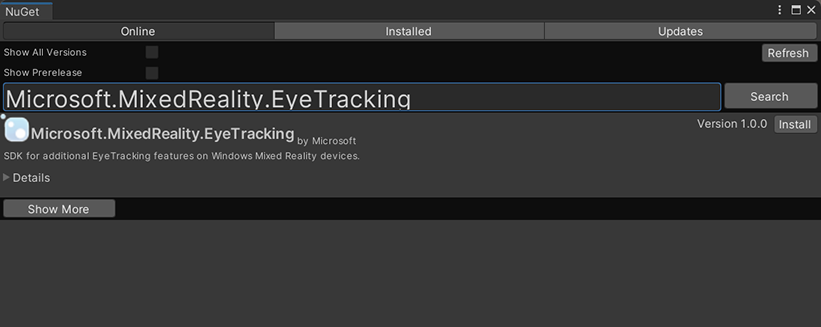Unity 中的延伸眼球追蹤
若要存取擴充眼球追蹤範例的 GitHub 存放庫:
延伸眼球追蹤是HoloLens 2的新功能。 這是標準眼球追蹤的超集合,只提供結合的眼球注視資料。 延伸眼球追蹤也提供個別的眼球注視資料,並允許應用程式為注視資料設定不同的畫面播放速率,例如 30、60 和 90fps。 目前HoloLens 2不支援其他功能,例如眼球開啟和眼球頂點。
擴充眼球追蹤 SDK可讓應用程式存取延伸眼球追蹤的資料和功能。 它可與 OpenXR API 或舊版 WinRT API 搭配使用。
本文涵蓋在 Unity 中使用擴充眼球追蹤 SDK 的方式,以及 Mixed Reality OpenXR 外掛程式。
專案設定
-
設定 HoloLens 開發的 Unity 專案。
- 選取注視輸入功能
- 從 MRTK 功能工具匯入 Mixed Reality OpenXR 外掛程式。
- 將眼球追蹤 SDK NuGet 套件匯入 Unity 專案。
- 下載並安裝 NuGetForUnity 套件。
- 在 Unity 編輯器中,移至
NuGet- >Manage NuGet Packages,然後搜尋Microsoft.MixedReality.EyeTracking - 按一下 [安裝] 按鈕以匯入最新版本的 NuGet 套件。

- 新增 Unity 協助程式腳本。
-
從這裡將
ExtendedEyeGazeDataProvider.cs腳本新增至您的 Unity 專案。 - 建立場景,然後將腳本附加
ExtendedEyeGazeDataProvider.cs至任何 GameObject。
-
從這裡將
- 取用 的 函
ExtendedEyeGazeDataProvider.cs式並實作邏輯。 - 建置並部署至 HoloLens。
取用 ExtendedEyeGazeDataProvider 的函式
注意
腳本 ExtendedEyeGazeDataProvider 取決於來自 Mixed Reality OpenXR 外掛程式的一些 API,以轉換注視資料的座標。 如果您的 Unity 專案使用已取代的 Windows XR 外掛程式或舊版 Unity 中的舊版內建 XR,則無法運作。 若要讓延伸眼球追蹤在這些案例中運作:
- 如果您只需要存取畫面播放速率設定,則不需要Mixed Reality OpenXR 外掛程式,而且您可以修改
ExtendedEyeGazeDataProvider,只保留畫面播放速率相關的邏輯。 - 如果您仍然需要存取個別的眼球注視資料,則必須 在 Unity 中使用 WinRT API。 若要瞭解如何搭配 WinRT API 使用延伸眼球追蹤 SDK,請參閱一節。
類別會 ExtendedEyeGazeDataProvider 包裝延伸眼球追蹤 SDK API。 它提供可在 Unity 世界空間或相對於主相機的注視讀取功能。
以下是用來 ExtendedEyeGazeDataProvider 取得注視資料的程式碼範例。
ExtendedEyeGazeDataProvider extendedEyeGazeDataProvider;
void Update() {
timestamp = DateTime.Now;
var leftGazeReadingInWorldSpace = extendedEyeGazeDataProvider.GetWorldSpaceGazeReading(extendedEyeGazeDataProvider.GazeType.Left, timestamp);
var rightGazeReadingInWorldSpace = extendedEyeGazeDataProvider.GetWorldSpaceGazeReading(extendedEyeGazeDataProvider.GazeType.Right, timestamp);
var combinedGazeReadingInWorldSpace = extendedEyeGazeDataProvider.GetWorldSpaceGazeReading(extendedEyeGazeDataProvider.GazeType.Combined, timestamp);
var combinedGazeReadingInCameraSpace = extendedEyeGazeDataProvider.GetCameraSpaceGazeReading(extendedEyeGazeDataProvider.GazeType.Combined, timestamp);
}
ExtendedEyeGazeDataProvider當腳本執行時,它會將注視資料畫面播放速率設定為最高選項,也就是目前為 90fps。
擴充眼球追蹤 SDK 的 API 參考
除了使用 ExtendedEyeGazeDataProvider 腳本之外,您也可以建立自己的腳本來直接取用 SDK API。
namespace Microsoft.MixedReality.EyeTracking
{
/// <summary>
/// Allow discovery of Eye Gaze Trackers connected to the system
/// This is the only class from the Extended Eye Tracking SDK that the application will instantiate,
/// other classes' instances will be returned by method calls or properties.
/// </summary>
public class EyeGazeTrackerWatcher
{
/// <summary>
/// Constructs an instance of the watcher
/// </summary>
public EyeGazeTrackerWatcher();
/// <summary>
/// Starts trackers enumeration.
/// </summary>
/// <returns>Task representing async action; completes when the initial enumeration is completed</returns>
public System.Threading.Tasks.Task StartAsync();
/// <summary>
/// Stop listening to trackers additions and removal
/// </summary>
public void Stop();
/// <summary>
/// Raised when an Eye Gaze tracker is connected
/// </summary>
public event System.EventHandler<EyeGazeTracker> EyeGazeTrackerAdded;
/// <summary>
/// Raised when an Eye Gaze tracker is disconnected
/// </summary>
public event System.EventHandler<EyeGazeTracker> EyeGazeTrackerRemoved;
}
/// <summary>
/// Represents an Eye Tracker device
/// </summary>
public class EyeGazeTracker
{
/// <summary>
/// True if Restricted mode is supported, which means the driver supports providing individual
/// eye gaze vector and frame rate
/// </summary>
public bool IsRestrictedModeSupported;
/// <summary>
/// True if Vergence Distance is supported by tracker
/// </summary>
public bool IsVergenceDistanceSupported;
/// <summary>
/// True if Eye Openness is supported by the driver
/// </summary>
public bool IsEyeOpennessSupported;
/// <summary>
/// True if individual gazes are supported
/// </summary>
public bool AreLeftAndRightGazesSupported;
/// <summary>
/// Get the supported target frame rates of the tracker
/// </summary>
public System.Collections.Generic.IReadOnlyList<EyeGazeTrackerFrameRate> SupportedTargetFrameRates;
/// <summary>
/// NodeId of the tracker, used to retrieve a SpatialLocator or SpatialGraphNode to locate the tracker in the scene
/// for the Perception API, use SpatialGraphInteropPreview.CreateLocatorForNode
/// for the Mixed Reality OpenXR API, use SpatialGraphNode.FromDynamicNodeId
/// </summary>
public Guid TrackerSpaceLocatorNodeId;
/// <summary>
/// Opens the tracker
/// </summary>
/// <param name="restrictedMode">True if restricted mode active</param>
/// <returns>Task representing async action; completes when the initial enumeration is completed</returns>
public System.Threading.Tasks.Task OpenAsync(bool restrictedMode);
/// <summary>
/// Closes the tracker
/// </summary>
public void Close();
/// <summary>
/// Changes the target frame rate of the tracker
/// </summary>
/// <param name="newFrameRate">Target frame rate</param>
public void SetTargetFrameRate(EyeGazeTrackerFrameRate newFrameRate);
/// <summary>
/// Try to get tracker state at a given timestamp
/// </summary>
/// <param name="timestamp">timestamp</param>
/// <returns>State if available, null otherwise</returns>
public EyeGazeTrackerReading TryGetReadingAtTimestamp(DateTime timestamp);
/// <summary>
/// Try to get tracker state at a system relative time
/// </summary>
/// <param name="time">time</param>
/// <returns>State if available, null otherwise</returns>
public EyeGazeTrackerReading TryGetReadingAtSystemRelativeTime(TimeSpan time);
/// <summary>
/// Try to get first first tracker state after a given timestamp
/// </summary>
/// <param name="timestamp">timestamp</param>
/// <returns>State if available, null otherwise</returns>
public EyeGazeTrackerReading TryGetReadingAfterTimestamp(DateTime timestamp);
/// <summary>
/// Try to get the first tracker state after a system relative time
/// </summary>
/// <param name="time">time</param>
/// <returns>State if available, null otherwise</returns>
public EyeGazeTrackerReading TryGetReadingAfterSystemRelativeTime(TimeSpan time);
}
/// <summary>
/// Represents a frame rate supported by an Eye Tracker
/// </summary>
public class EyeGazeTrackerFrameRate
{
/// <summary>
/// Frames per second of the frame rate
/// </summary>
public UInt32 FramesPerSecond;
}
/// <summary>
/// Snapshot of Gaze Tracker state
/// </summary>
public class EyeGazeTrackerReading
{
/// <summary>
/// Timestamp of state
/// </summary>
public DateTime Timestamp;
/// <summary>
/// Timestamp of state as system relative time
/// Its SystemRelativeTime.Ticks could provide the QPC time to locate tracker pose
/// </summary>
public TimeSpan SystemRelativeTime;
/// <summary>
/// Indicates of user calibration is valid
/// </summary>
public bool IsCalibrationValid;
/// <summary>
/// Tries to get a vector representing the combined gaze related to the tracker's node
/// </summary>
/// <param name="origin">Origin of the gaze vector</param>
/// <param name="direction">Direction of the gaze vector</param>
/// <returns></returns>
public bool TryGetCombinedEyeGazeInTrackerSpace(out System.Numerics.Vector3 origin, out System.Numerics.Vector3 direction);
/// <summary>
/// Tries to get a vector representing the left eye gaze related to the tracker's node
/// </summary>
/// <param name="origin">Origin of the gaze vector</param>
/// <param name="direction">Direction of the gaze vector</param>
/// <returns></returns>
public bool TryGetLeftEyeGazeInTrackerSpace(out System.Numerics.Vector3 origin, out System.Numerics.Vector3 direction);
/// <summary>
/// Tries to get a vector representing the right eye gaze related to the tracker's node position
/// </summary>
/// <param name="origin">Origin of the gaze vector</param>
/// <param name="direction">Direction of the gaze vector</param>
/// <returns></returns>
public bool TryGetRightEyeGazeInTrackerSpace(out System.Numerics.Vector3 origin, out System.Numerics.Vector3 direction);
/// <summary>
/// Tries to read vergence distance
/// </summary>
/// <param name="value">Vergence distance if available</param>
/// <returns>bool if value is valid</returns>
public bool TryGetVergenceDistance(out float value);
/// <summary>
/// Tries to get left Eye openness information
/// </summary>
/// <param name="value">Eye Openness if valid</param>
/// <returns>bool if value is valid</returns>
public bool TryGetLeftEyeOpenness(out float value);
/// <summary>
/// Tries to get right Eye openness information
/// </summary>
/// <param name="value">Eye openness if valid</param>
/// <returns>bool if value is valid</returns>
public bool TryGetRightEyeOpenness(out float value);
}
}